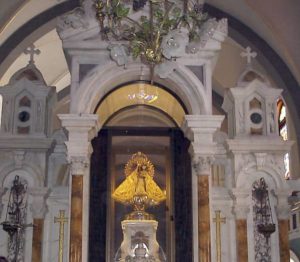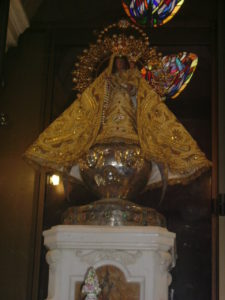La Basílica Santuario Nacional de Nuestra Señora de la Caridad del Cobre es una basílica menor católica romana dedicada a la Santísima Virgen María ubicada en Santiago de Cuba, Cuba.
La historia de El Santuario del Cobre, comienza cuando la Virgen de la Caridad fue encontrada en la bahía de Nipe en 1608 por los hermanos Juan y Rodrigo de Hoyos y un joven negro de nombre Juan Moreno, todos ellos naturales del distrito El Cobre, 12 millas de Santiago de Cuba.
La imagen se colocó primero en un pequeño altar de Barajagua, ya que el altar mayor de la iglesia de El Cobre pertenecía a Santiago Apóstol y las otras dos iglesias las ocupaban Santa Bárbara y Nuestra Señora del Rosario.
Luego, junto a la iglesia se construyó una ermita y poco después, a finales del siglo XVIII, comenzó a nacer la fama milagrosa y con ella la historia legendaria de la Virgen del Cobre, dando lugar a la paulatina disminución de la adoración a la imagen de Santiago Apóstol.
En 1915 los Veteranos de la Guerra de la Independencia, solicitan al Papa Benedicto XV que proclame a la Virgen del Cobre como Patrona de Cuba, y lo hace el 10 de mayo de 1916.
EL SANTUARIO CUBANO DEL COBRE…
El Santuario del Cobre es destino obligado para los devotos de la Patrona de Cuba, que acuden muchas veces a este templo para pagar promesas.
Las ofrendas se acumulan y depositan en la “Capilla de os Milagros”: joyas de oro y piedras preciosas, muletas, otras riquezas de diversos valores y hasta la medalla de oro ganada en 1954 por el escritor norteamericano Ernest Hemingway con el Premio Nobel.
El peregrino lleva consigo piedritas de la mina y las guarda en las casas dentro de vasijas litúrgicas, bolsillos o bolsos, como protección contra los malos o tal vez como buena luz para el futuro personal y familiar.
La Virgen se ha situado en las tres últimas Iglesias, una seguida de la otra, edificada en El Cobre. La iglesia actual es la tercera que ha tenido la Virgen cuya fiesta es el 8 de septiembre y la Iglesia actual fue construida siendo vasco español Fray Valentín Zubizarreta (Arzobispo de Santiago de Cuba) el 8 de septiembre de 1927.
El 20 de diciembre de 1936 por órdenes del Papa Pío XI se corona la imagen de la virgen en solemne ceremonia realizada en la Rambla de Santiago de Cuba.
En diciembre de 1977, el Papa Pablo VI concedió a la iglesia el título de Basílica, cargo que desempeñó el cardenal africano Bernardino Cantín.
El 24 de enero de 1998, durante la visita del Papa Juan Pablo II, coronó a la Virgen durante la misa celebrada en la Plaza de la Revolución Antonio Maceo de Santiago de Cuba y colocó entre sus manos un rosario de oro.
En la iglesia se encuentra la imagen de la Virgen dentro de una urna de vidrio dentro de la cual se dan especiales condiciones climáticas. Se sitúa en el llamado “Camerín de la Virgen” donde asisten sus fieles a rezar y poner flores. Cuando comienza la misa la imagen de la Virgen gira hacia el templo, sobre el altar mayor poniendo su rostro hacia el pueblo. Una vez que la masa termina, gira de nuevo.
Se hace antes de forma manual y ahora de forma electrónica con la urna que se adquirió en Montreal, Canadá, de donde viene también el candelero que pende en el cuarto de la Virgen. El manto que vistió fue bordado en oro por unas monjas de clausura en España.
A través del tiempo la imagen de La Virgen de la Caridad (Cachita, como la llaman muchos) ha servido para realizar múltiples peticiones por parte de los creyentes que piden consuelo ante los dolores, misericordia y paz en los momentos de más tensión, libertad y desahogo en las batallas, etc.

* LOS QUE OLVIDAN SU HISTORIA ESTAN CONDENADOS A REPETIRLA.
* THOSE WHO FORGET THEIR HISTORY ARE CONDEMNED TO REPEAT IT.
OUR NATIONAL BASILICA SANTUARIO OF THE VIRGEN DE LA CARIDAD DEL COBRE. PHOTOS
The history of El Santuario del Cobre begins when La Virgen de la Caridad was founded in the bay of Nipe in 1608 for the siblings Juan and Rodrigo de Hoyos and a young black man named Juan Moreno, all them natural of the district El Cobre, 12 miles from Santiago de Cuba.
The image was placed first in a small altar in Barajagua since the main altar of the church of El Cobre belonged to Santiago Apostle and the other two churches were occupied by Santa Bárbara and Nuestra Señora del Rosario.
Then, next to the church was built a hermitage and soon after, at the end of the XVIII century, it began to born the miraculous fame and with her the legendary history of La Virgen del Cobre, giving rise to the gradual decrease of the adoration to the image of Santiago Apostle.
In 1915 the Veterans of Independence Guerra requested Pope Benedicto XV to proclaim L Virgen del Cobre as Patron Saint from Cuba, and she’s it done May 10, 1916.
El Cobre Sanctuary is a destination forced for the devote ones of the Patron Saint from Cuba, and they go to this temple many times to pay promises.
The offerings are accumulated and deposited in “Capilla de os Milagros”: jewels of gold and precious stones, crutches, other wealth of diverse values and until the medal of gold won in 1954 by the North American writer Ernest Hemingway with Nobel Prize.
The pilgrims take with them tiny stones of the mine and keep them in houses within the liturgical vessels, pockets, or handbags, as protection against the bad ones or maybe as good light for the personal and family future.
The Virgin has placed in the last three Churches, followed by the other one, built in The Copper. The current church is the third that has had the Virgin whose party is September 8 and the current Church was built being the Basque Spanish Friar Valentín Zubizarreta (Archbishop of Santiago de Cuba ) on September 8, 1927.
December 20 1936 orders of Pope Pío XI the virgin’s image is crowned in the solemn ceremony made on the Boulevard of Santiago de Cuba.
In December of 1977, Pope Pablo VI granted the title of Basilica to the church, a responsibility carried out by the African Cardinal Bernardino Cantín.
On January 24 1998, during Pope Juan Pablo II’s visit, crowned the Virgin during the mass that took place in the Plaza de la Revolución Antonio Maceo of Santiago de Cuba and he placed among her hands a rosary of gold.
In the church, the Virgin’s image is found inside a glass urn within which there are special climatic conditions. It is placed in the called “Camerín de la Virgen” where her faithful ones attend to pray and to put flowers. When the mass starts the Virgin’s image rotates toward the temple, on the biggest altar putting on her face toward the people. Once the mass ends up, she rotates again.
It’s done before manually and now electronically with the urn that was acquired in Montreal, Canada, where the candlestick that lolls in the Virgin’s room also comes. The mantel that she dressed was embroidered in gold by some closing nuns in Spain.
Through time the image of La Virgen de la Caridad (Cachita, as many people, calls her) has been useful to make multiple petitions on the part of the believers that request comfort in the face of the pain, mercy, and peace in the moments of more tension, freedom, and relief in the battles, etc.
Agencies/ Cubanismos/ CaridadCobreHist. / Extractos/ Excerpts/ Internet Photos/ Arnoldo Varona/ www.TheCubanHistory.com
THE CUBAN HISTORY, HOLLYWOOD.

* LOS QUE OLVIDAN SU HISTORIA ESTAN CONDENADOS A REPETIRLA.
* THOSE WHO FORGET THEIR HISTORY ARE CONDEMNED TO REPEAT IT.



 NUESTRA Basilica Santuario Nacional de la Virgen de la Caridad del Cobre. PHOTOS. * OUR NATIONAL Basilica Santuario of the Virgen de la Caridad del Cobre. PHOTOS.
NUESTRA Basilica Santuario Nacional de la Virgen de la Caridad del Cobre. PHOTOS. * OUR NATIONAL Basilica Santuario of the Virgen de la Caridad del Cobre. PHOTOS.




